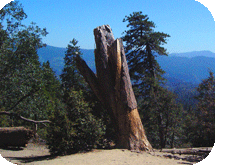
This mailer has been provided as an avenue of dispersing information related to landscape architecture in hopes of fostering greater understanding and collaboration between professions. Topics address issues that affect the built environment within which we live.
"In wilderness is the preservation of the world."Henry David Thoreau
As budget difficulties continue to plague the State of California, the State Parks system continues to lose funding and is forced to limit recreational services and close facilities. Earlier this year, California State Parks announced that, in its efforts to reduce budgets by $11 million, 70 of its 278 parks would be closing. These closures are to begin this month and will be fully implemented by July of 2012. Further disturbing, is the unpleasant reality that next year the parks system must cut an additional $11 million dollars from the budget. This being said, things could be worse!
 Planned State Park Closures - On a positive note, only 70 parks (25%) are slated for closure. In the past as many as 220 of the 278 parks have been targeted for closure. Innately tied to the closure of these 70 parks (Click here to see an interactive park closure map), is a significant reduction in recreational opportunities, reduction in exposure to natural settings and an increase in traffic to other state parks. Based on last year's visitation numbers, 5.3 million people visited the closing 70 parks. The realization that remaining State parks will need to flex in order to accommodate those displaced park users, cannot be ignored. Surely the decision to close these parks was not easy and required much compromise and contemplation. According to a news release by the California Department of Parks and Recreation, park closures were determined based on criteria including: statewide significance, visitation, fiscal strength, existing partnerships, infrastructure and land use restrictions. A detailed spreadsheet (Click here) obtained from the State contains detailed information related to the operation costs, annual attendance, revenues, closure savings and costs associated with each park closing. Those interested in saving parks, with the aid of this report, now know exactly how much is needed to save each of the State Parks!
Planned State Park Closures - On a positive note, only 70 parks (25%) are slated for closure. In the past as many as 220 of the 278 parks have been targeted for closure. Innately tied to the closure of these 70 parks (Click here to see an interactive park closure map), is a significant reduction in recreational opportunities, reduction in exposure to natural settings and an increase in traffic to other state parks. Based on last year's visitation numbers, 5.3 million people visited the closing 70 parks. The realization that remaining State parks will need to flex in order to accommodate those displaced park users, cannot be ignored. Surely the decision to close these parks was not easy and required much compromise and contemplation. According to a news release by the California Department of Parks and Recreation, park closures were determined based on criteria including: statewide significance, visitation, fiscal strength, existing partnerships, infrastructure and land use restrictions. A detailed spreadsheet (Click here) obtained from the State contains detailed information related to the operation costs, annual attendance, revenues, closure savings and costs associated with each park closing. Those interested in saving parks, with the aid of this report, now know exactly how much is needed to save each of the State Parks!
Saving Our Parks- Advocating for parks on a political level may be the most effective method of securing future funds to keep parks open, however, this can be frightening and frankly, often convoluted and confusing for many of us. Most of us would be better off writing a letter to the State Legislature, joining an advocacy group or parks partnership group, or offering our own personal resources to help keep parks in operation. There are many resources to help in this endeavor and special interest groups exist which actively campaign for state parks; a few include:
One of these, the Olmsted Park Fund, was formed to avoid closures of the many parks John Omlsted was so instrumental in establishing. The fund's marketing slogan is, "$1 from every California resident will save our state parks!". The slogan is built on the premise that if each California resident were to give only $1, the $22 million cuts to parks could be avoided and parks would remain open. Realistically, not every California resident will give, or will even hear about this effort. Thus, the fund is currently focusing on the preservation of only a handful of parks. The goal is to raise $300,000 and keep open the twelve most feasible parks. Click on the link above to learn more.
 Park Partnership Operating Agreements - Another exciting possibility is the transfer of park operations and maintenance to non-profit groups through partnership agreements with state parks. The concept of using volunteers (to accomplish what can't be done otherwise) can be used at all levels of government and has been shown to be successful and effective when managed correctly. At the state level, Assembly Bill 42 has not only been introduced, but passed and is now waiting for the Governor's signature. This bill allows the State to partner with non-profit organizations for operation and management of state parks. In addition to the potential reduction in operating costs, non-profit organizations may be beneficial to parks through their ability to raise philanthropic support, receive donations and manage in-kind support to help keep parks running.
Park Partnership Operating Agreements - Another exciting possibility is the transfer of park operations and maintenance to non-profit groups through partnership agreements with state parks. The concept of using volunteers (to accomplish what can't be done otherwise) can be used at all levels of government and has been shown to be successful and effective when managed correctly. At the state level, Assembly Bill 42 has not only been introduced, but passed and is now waiting for the Governor's signature. This bill allows the State to partner with non-profit organizations for operation and management of state parks. In addition to the potential reduction in operating costs, non-profit organizations may be beneficial to parks through their ability to raise philanthropic support, receive donations and manage in-kind support to help keep parks running.
Unfortunately, there is no quick solution to the park closure dilemma. What is important however, is that there are dedicated, passionate people who believe society needs opportunities to recreate and enjoy nature. These individuals are trying to attack this large issue one step at a time and are in turn creating opportunities for the rest of us to become involved and to try and make a difference.
Prior Issues of Interest
- Nature Series: Nature Deficit Disorder
- Nature Series: The Healing Power of Nature
- Nature Series: Infusing Nature into Play
- The Parks and Rec Budget Reduction Trend
- Artificial Landscape Water Cycles
The next time you need a Landscape Architect on your project, consider O'Dell Engineering's Landscape Architecture Department.
Services include:
- Park and Playground Design
- Recreational Facility Design
- Site Planning
- Streetscape Design
- Urban Design
- Commercial Design
- Model / Production Homes
- 3-D Visualizations
- Graphic Design
- Arboriculture Consulting
- Playground Inspection
Author: Chad Kennedy, Landscape Architect
This informational article provided by O'Dell Engineering - 1165 Scenic Drive, Suite A, Modesto CA 95350